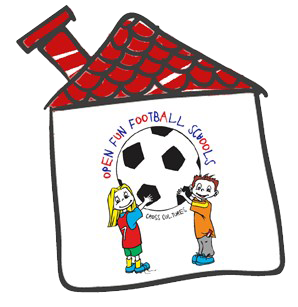The training ground
Rope games
Exercises and games with ropes are one of the GAME cycle stations that capture childrens attention and awaken great interest. This year, we are proud to offer you some new ideas regarding the organisation of this particular station. We consider the rope to be not only a prop used for jumping or pulling. It is also a powerful tool for organising and making very different and interesting obstacles, corridors and goals. Exercises and games in this setup help children improve their ball control technique (passing/receiving, dribbling, and feints, etc.).
ROPE IN A STRAIGHT LINE
Dribbling and stopping the ball using various techniques (dribbling with the sole, the inner, or the outer side of the foot, etc.), turning and dribbling backwards from both sides of the rope, and inserting more complex tasks into the exercise. There are two ways in which you can play this:
The players either return to their own group, or
They cross to the other group.
Based on such an organisation, you can create a complete training schedule or a part of it, leaving the possibility for other technical elements to be combined, including the basic and specific kicks, long and short passes, the finishing, etc.

ROPE IN A ZIGZAG LINE
The station is organised as in the exercise above, except that all the tasks are made more complex by frequent changes of direction. When creating your own tasks, you should similarly use as many technical elements as you can, taking into account childrens age and abilities.
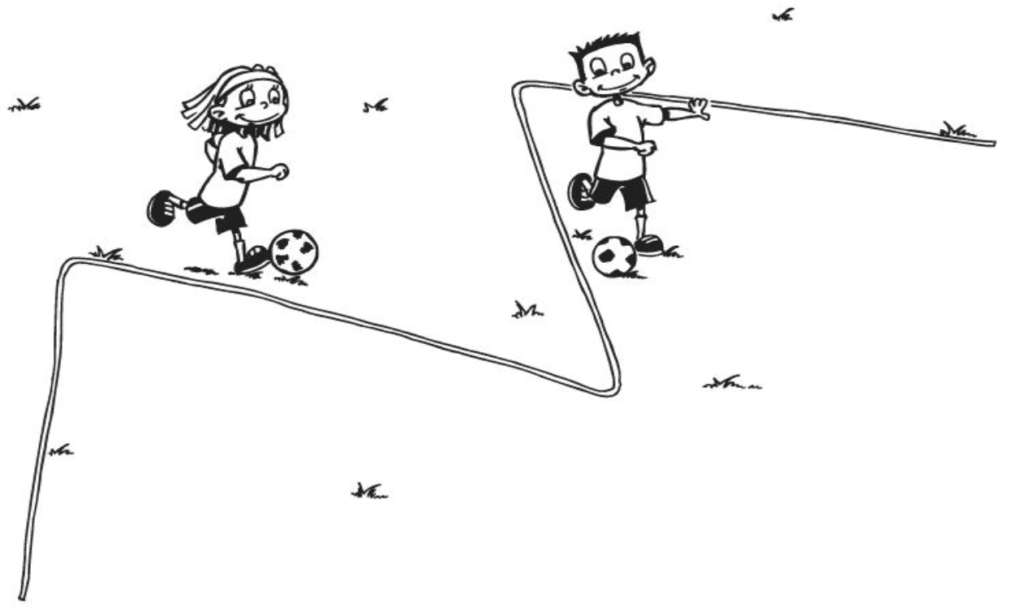
ROPE CORRIDORS
Mark several corridors (700-100 centimetres wide) with ropes. Players dribble their ball along the corridors using various techniques, returning through the corridors or along their outer sides, either returning to their own group, or crossing to the other. Arrange one or more cones along the corridors around which players can turn and go back to their group or cross to the other.

CRISSCROSS FORMATION
This is a very interesting organisation that leaves us with numerous opportunities for a great number of technical and tactical organisational tasks.
Dribbling the ball to and around the cone using all known techniques
Crossing to the other group without turning around the cone with 2 and with 4 balls
Crossing to the other group from the left or from the right side with 2, 3, or 4 balls
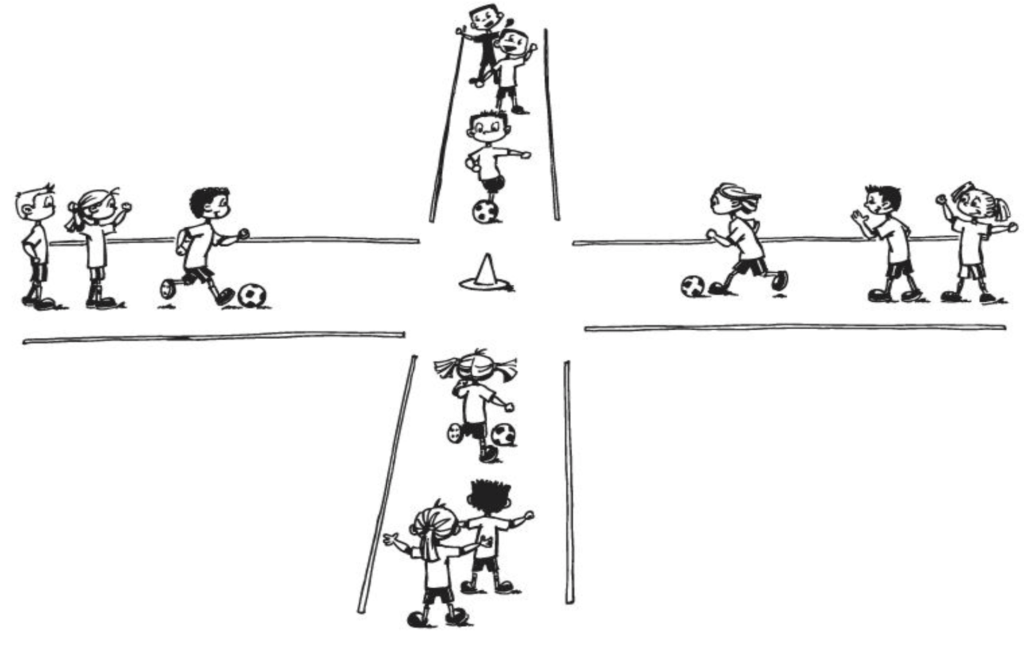
THREE-SIDED CORRIDORS
This setup is similar to our previous organisation however, here we have three groups of players working together, and they can either return to their own groups or cross to the other.
The second option would be to combine precision exercises and finish-offs with players either returning or crossing to the other group. Upon leaving the corridor, a coach or one of the players can step in and play a double pass with the player in the corridor or else he/she can dribble past them and shoot at the goal.
ROUND CORRIDORS
This is a very interesting set-up that gives us a number of opportunities such as exchange of positions, return to ones own group, change of course and direction of movement with the ball, and various forms of dribbling.

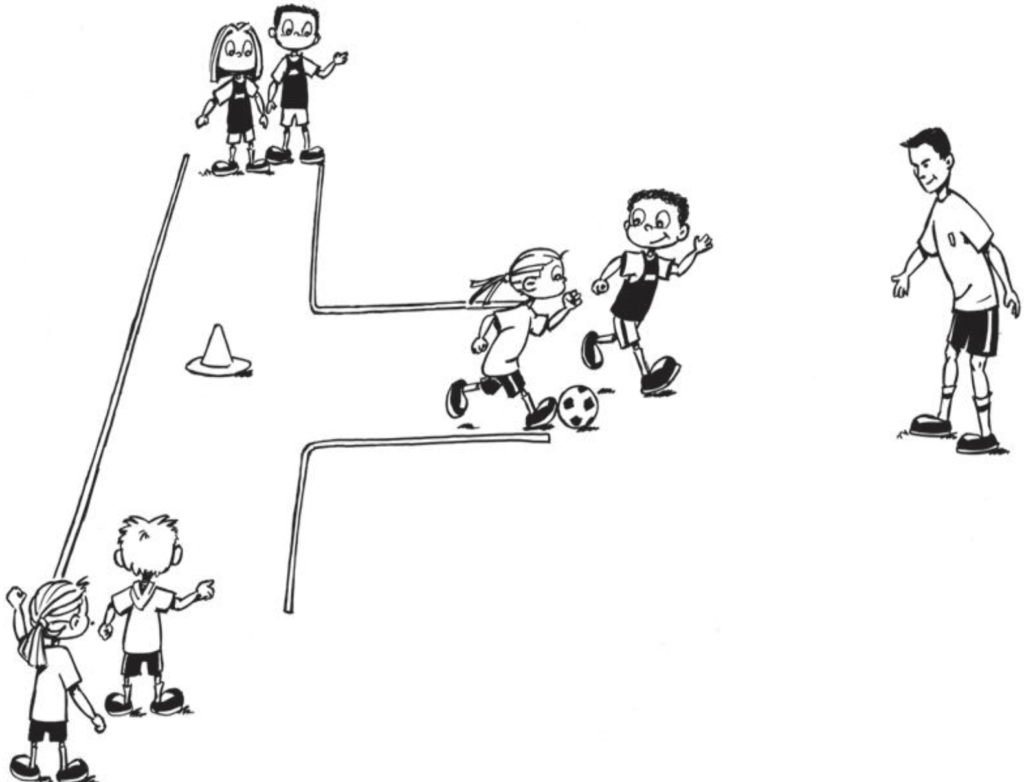
PAIRS IN FOURS WITH SHORT ROPES
One pair is holding the rope while the other is practicing. The height at which the rope is held is optional or in line with the technical requirements. (e.g. if you are practicing passes and reception, hold the rope at 30-40 centimetres; if practicing headers, the rope should be held at 100 centimetres from the ground). Change roles in even time sequences.


GAME
Two players hold the rope and move in circles around the station. The other two players pass the ball to one another but the ball has to go over or under the rope. Who will be the fastest to score 10 passes or who can pass more balls in a given time?
OBSTACLE COURSE
Several pairs are holding ropes; other pairs are passing and receiving the ball under the ropes and jumping or going under the ropes themselves to get to the end.
Passing the ball under the ropes individually, jumping over, or going under the ropes until the end of the course.

A LONG ROPE IN A CIRCLE
6-8 players are holding the rope at a height of one metre from the ground. The other players are each given a ball which they have to dribble around the circle using various dribbling techniques. At the coach’s signal, they quickly slide into the circle with the ball; at another signal they have to get out. Players should change their roles after a while. The game can also be played in such a way that the last one to get in or out of the circle drops out of the game.
There are several balls inside the circle around which the players are moving very slowly. There is always one ball less than there are players outside the circle. At the coach’s sign, the players have to get into the circle, take a ball, and get out. The player that is left without a ball drops out.
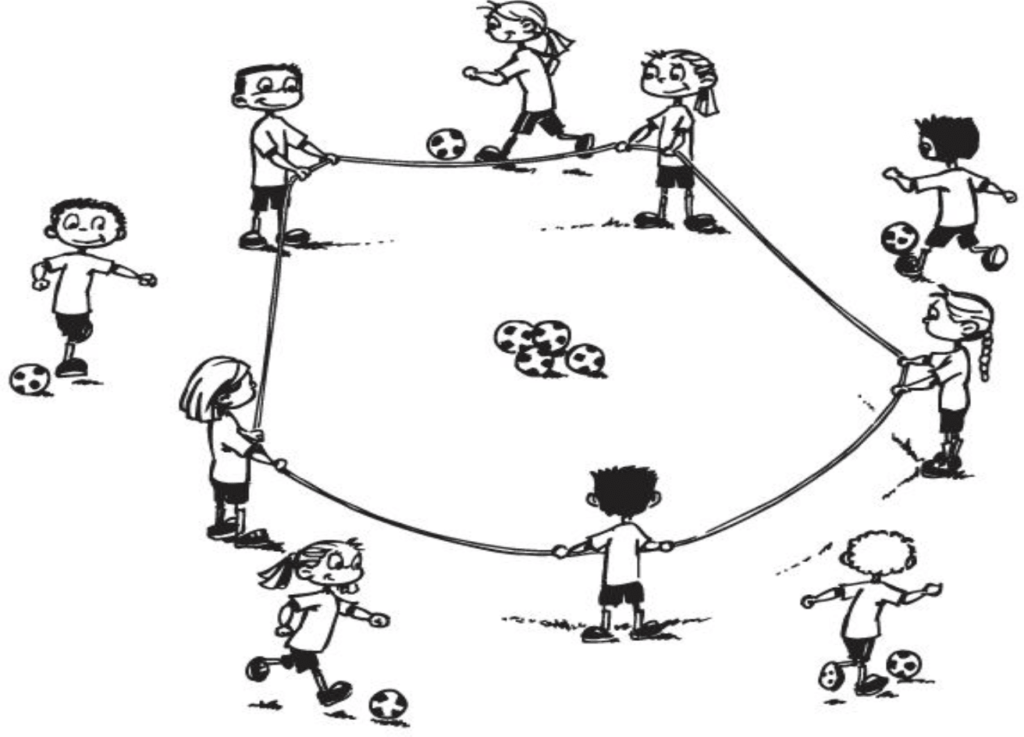
DIFFERENT FORMS OF ROPE GOALS AND GAMES
Rope goals are laid on the ground. Scoring by getting across the rope with the ball or by kicking it across the rope
A rope goal held up by two players at a certain height.
Two players are holding two ropes. They are pressing one rope with their feet. Having pulled the other rope under the one on the ground, they are holding it up tight with their hands. This interesting goal form gives us an opportunity to train children to be precise. They can also be used as goals for different forms of matches (4:4, 5:5, 6:6, etc.)


”Bull” game
The players are holding a rope in a circle. One of the players is inside. His/her task is to touch one of the players outside the rope who is trying to avoid contact by letting the rope go as the player approaches. They must be careful not to drop the rope fall on the ground. The player that fails to avoid contact has to get into the circle. The players around the rope tease the insider and then try to avoid him/her as quickly as they can.

Pulling The Rope
In pairs, fours or eights, or group against group; played either face to face or back to back.
Dragging the rope
The rope is in a quadrangle shape and on its two inner sides, there are four players holding another at hip-height. At a given signal, they start dragging the rope backwards. The team that manages to drag the other team to the little rope in the middle of the quadrangle wins.

Hanging hoops
Hang and tie 2, 3, or 4 hoops on a 3-4-metre long rope. The rope is held tight between two players at different heights (relative to the task and objective of the exercise). On both sides of the rope, players are practicing and improving certain skills and techniques. For practicing and improving the receiving and passing techniques and precision, the rope should be held in such a way that the hoops are touching the ground. The players task is to pass the ball through the hoops. These elements could also be practiced with the rope at medium height.
Apart from this, we can practice different header techniques (from a sitting, kneeling or squatting position). Holding the rope at maximum height poses the greatest challenge of all. Along with the football elements, we can practice and improve various volleyball, handball, or basketball techniques. Using our imagination, we can also come up with different tasks that include passing and getting through the hoops, changing positions, relays and a combination of all the afore-mentioned elements.

Option: horizontal hoops
Add another rope to the existing rope/hoop construction and tie the hoops in the same way but on the opposite side. That way, we will get a construction that players can hold horizontally or aslant (under a certain angle). There are numerous ways in which we can organise games and tasks at all heights. When holding the rope at a small height, players can practice various jumps with or without a ball, play relays, and get through the hoops. At a medium height, players practice different passes, play chasing games and relays, whereas by holding the ropes at maximum height, they can practice various precision techniques of different sports.
Viking fight
Two players are pulling a rope. The rope is tied to players waists while they are kneeling on their legs and hands. At a given signal, the players start pulling. The winner is the player who succeeds to drag his/her opponent to the rope in the centre. This can be a 1:1, 2:2, or 3:3 game.
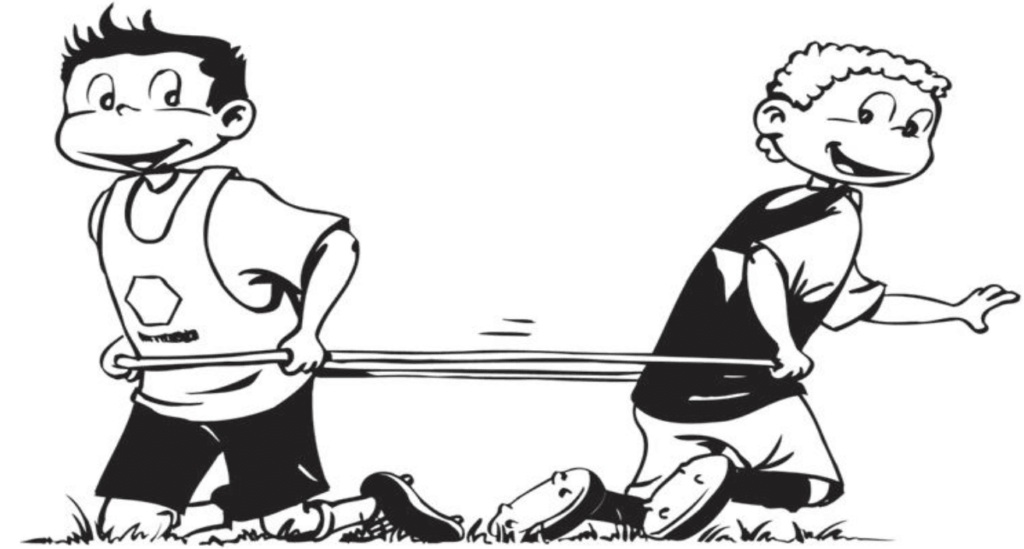
JUMPING A ROPE IN PAIRS
Players are turned face to face to one another. One player is turning the rope but both are jumping. Four ropes are turning in a row, while the players are standing in columns, jumping the ropes one by one. They have to go back the same way but this time either juggling or dribbling a ball. Those who make a mistake are eliminated.
A similar setup would be to have the players jump in pairs. They are holding hands, carrying a ball in the other at the same time. Once they get past all the four ropes, they have to shoot the ball into a basket (with the hand, foot, etc.).
Jumping the rope
Two players are turning a loose rope in place, while others are trying to run in and jump the rope in rhythm, either free-style or as directed by the coach (with both feet, from one foot to the other, with a jump between turns, etc.).
Option
The whole group can jump the rope at the same time and play until there is only one of them left.
The player should run through without touching the rope; they can run in pairs or threes, holding hands. Similarly, they can try to do all of the aforementioned but this time with a ball that needs to be dribbled through the turning rope.
Making waves
Two players are holding the rope tight at 1-metre height from the ground turning with it towards the group with the intention to trap someone at that particular height. Other players have to leap to save themselves. Those who get caught step in for the player who had previously been holding the rope or else they drop out of the game.
Option
A similar setup as above, except that the rope is at 20 centimetres height from the ground and that players can save themselves by jumping over it.
TAPPING WITH THE FOOT over the rope
Standing beside an outstretched rope, players have to perform different step-skip exercises moving as fast as they can. When the rope is to a players left side, he/she makes a step with the left foot, skipping the rope with the right, which is closer to it, touches the ground and lifts it back, without losing the rhythm of his/her movement. The same exercise should be done with the other foot. Once the player has reached the end of the rope, he/she starts sprinting with or without changing his/her direction.
Should you wish to build up on this game, you can use more ropes and arrange them in a zigzag line, whereby players, when crossing from one rope to the other, have to change their direction, rhythm and work with their left and right foot.
Additionally, the following exercises should include working with the ball and dribbling and ball control exercises (with different parts of the foot).
Jumping rope slalom
Players are divided into four columns. Each player has a jumping rope. At a given signal, a player from each column starts jumping his/her rope moving around the cones, doing the same thing on his/her way back. The winner is the column whose players finish first.
